One of the most spectacular and awesome waterfall hikes on southern Vancouver Island is also one that receives surprisingly little attention or traffic. It’s not too surprising – even my expectations for Christie Falls were pretty low. The hike in follows a boring logging road for the first half – with views of unspectacular forest and piles of dumped garbage. The second half of the hike is what really shines though, and what blew my expectations out of the water. I can safely say Christie Falls is one of the best waterfalls on Vancouver island, and one that you should definitely visit.
Singletrack trail turns off of the logging road eventually at the Bush Creek Hatchery, and follows up closely alongside Bush Creek as it crashes down several small drops. The hike here is a little steep and rooty, but nothing anyone used to Vancouver Island hikes shouldn’t be used to. The views of the creek are lovely, and there are numerous unnamed waterfalls that are worth your time. Upstream, Bush Creek splits into two separate creeks, Greater and Lesser Bush Creek, both of which drop down into spectacular waterfalls before the creek reunites further down.
The Christie Falls trail first leads to Lesser Christie Falls, which unleashes an impressive barrage of spray. Fortunately a side trail approaches the waterfall, allowing hikers to get as close as they’d like to this impressive Vancouver Island waterfall. From here the trail crosses a log bridge and proceeds the short distance to Greater Christie Falls, the larger of the two waterfalls, and a fantastic end-point to the hike. Adventurous hikers may continue even further upstream from here though via a steep roped trail to the point where Bush Creek originally diverges just after crashing down Upper Christie Falls, a smaller but very beautiful waterfall.
It’s possible to return to the logging road from Christie Falls the same way, or to take an alternate quicker route that leads past an old cabin not far from the waterfalls. Personally I prefer the walk alongside the creek but the steep grade can be a bit challenging especially on the descent, so wtaking the cabin route back is a great option for those looking for an easy walk back to the trailhead.
Continue reading this blog post for everything you need to know to experience the Christie Falls hike on Vancouver Island for yourself, including distance, elevation gain, how to get there, the best time to visit, and lots of photos of my experience, or check out my complete list of waterfalls near Nanaimo.
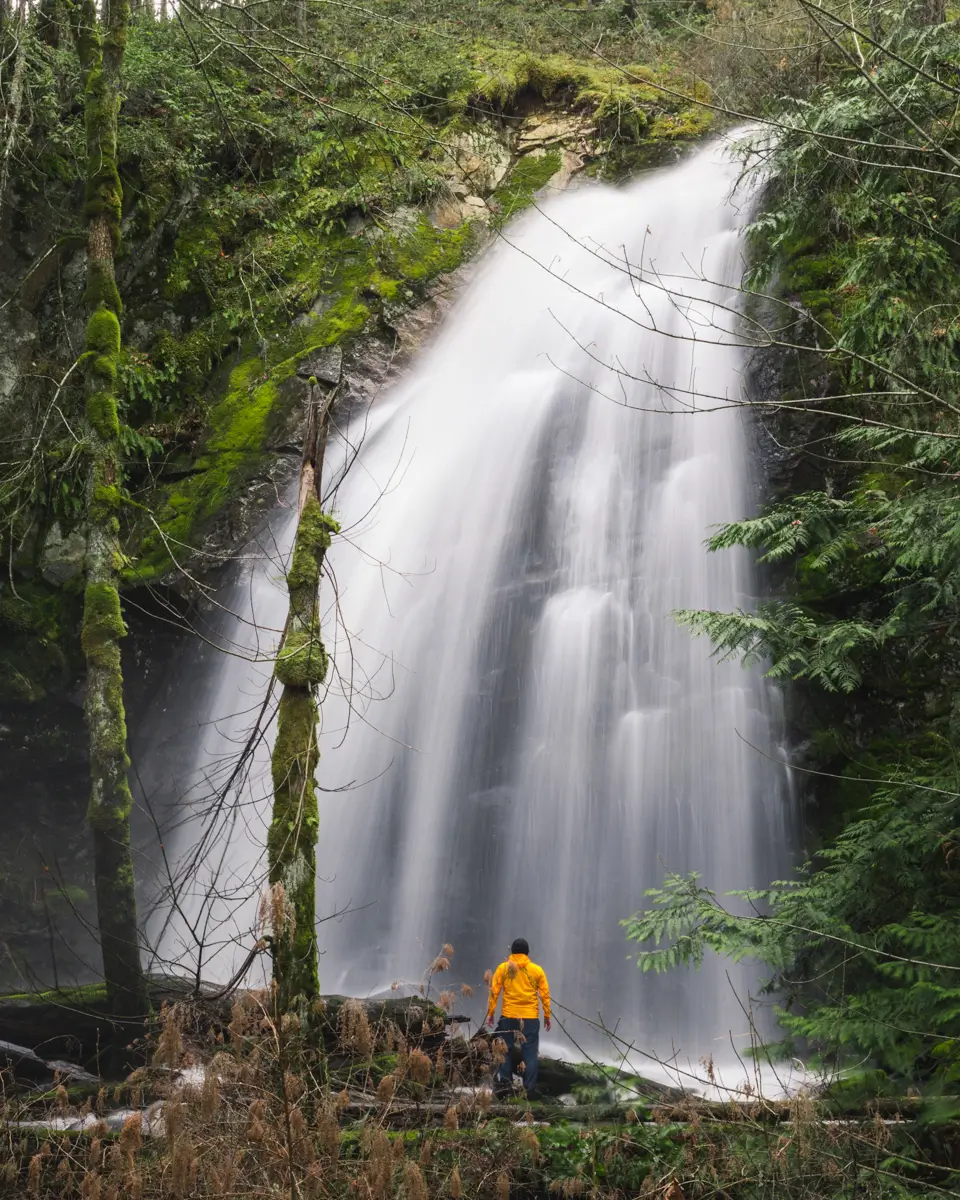
Lesser Christie Falls
When hiking it’s important to avoid harmful practices such as disturbing plants or rock-stacking, or removing any natural object from flowers to rocks, as it’s important to leave the environment as natural as possible for the animals and for fellow hikers to enjoy in perpetuity. As many flowers as there are, there are few enough that if we all took one, then there wouldn’t be any left. Take only photos, leave only footprints.
If you haven’t heard of Leave No Trace principles, they’re also really essential to read up on before heading anywhere into the outdoors in general. Following these important principles basically means doing your best to leave beautiful places like Christie Falls as good (if not better) than you found them, both for their preservation and for the enjoyment of other visitors.
Read: Eight More Nanaimo Waterfalls
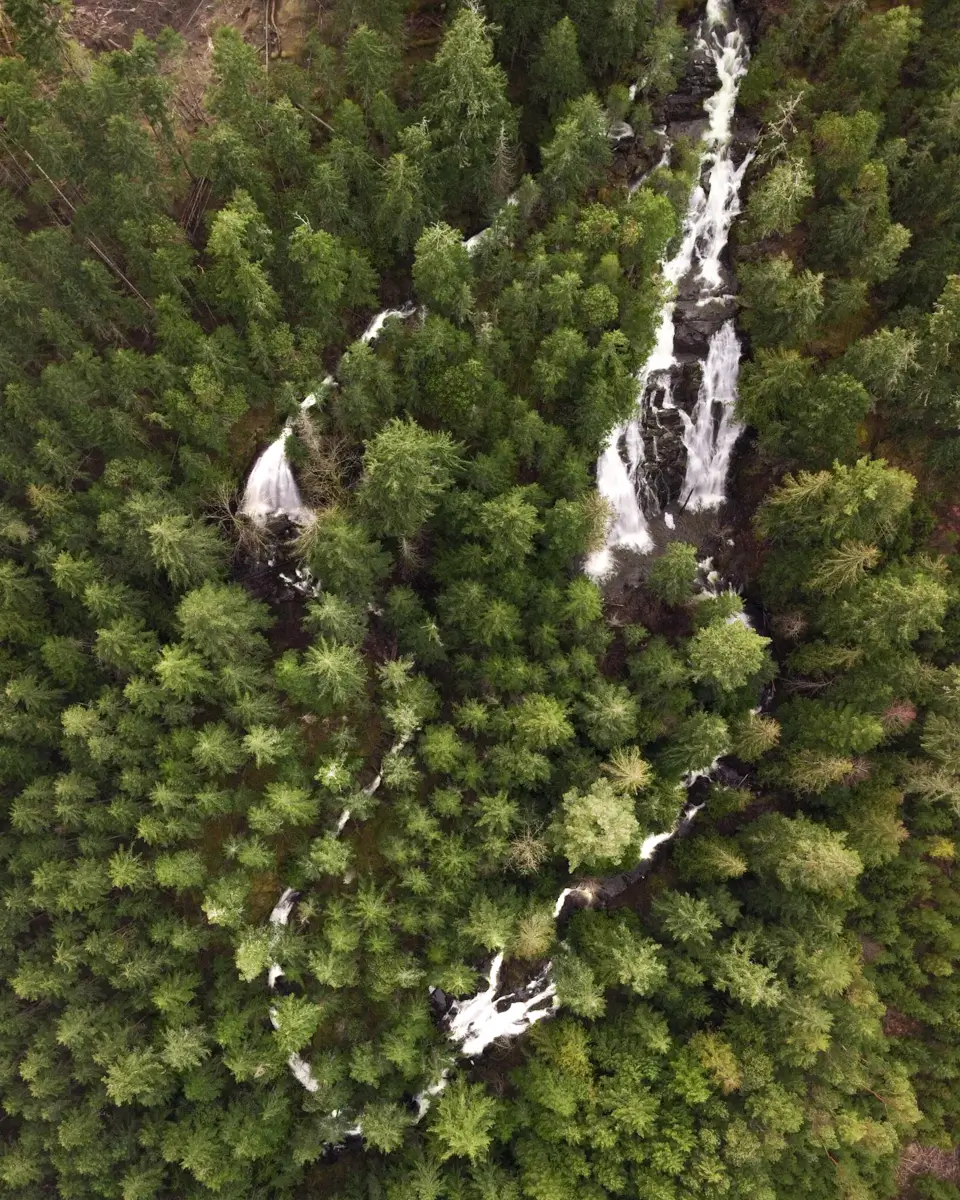
Christie Falls as seen from above, with the edge of a cut block seen at top left. At the top right is Upper Christie Falls, where Bush Creek splits into Lesser Bush Creek and Greater Bush Creek, producing Lesser Christie Falls (left) and Greater Christie Falls (right.) At the bottom where the two creeks rejoin is Lower Christie Falls.
Christie Falls Round Trip Details
Distance: 6.9 KM / 4.3 MI
Elevation Gain: 136 M / 446 FT
Hiking Time: 2 HRS
Hiking & Safety Tips
- Prepare for the possibility of wildlife encounters. There are almost no grizzly bears on Vancouver Island, but black bears are still common. Bear bells are proven to be an ineffective bear deterrent, and are even actively discouraged by Parks Canada. The best way to let bears know you’re around is simply to use your voice. Make sure to keep a respectful distance from wildlife and never feed the animals. It may seem kind but it doesn’t just kill wildlife and put people in danger, it’s also in many cases illegal.
- Research current trail conditions and make sure you are well-informed about the route before you leave, and assess if it is within your capability. Be aware of what time it gets dark and check the weather forecast. Make sure to tell someone where you’re going and when you expect to return. Every year as more and more people try hiking for the first time, the number of rescues goes up. Being prepared is the best defense.
- Pack everything you need for a successful hike, including enough water and energy-rich snacks. Remember to pack out everything you pack in though – don’t expect to find a convenient garbage can halfway up the trail. Bring appropriate layers (remember you’ll warm up once you start hiking) and sun protection. Hiking poles may be helpful but are not required. In addition to not leaving any garbage on the trail yourself, I highly recommend bringing a garbage bag and collecting any trash that you do see on the trail. You’re guaranteed to make the hike to Christie Falls a more enjoyable experience for the next person.
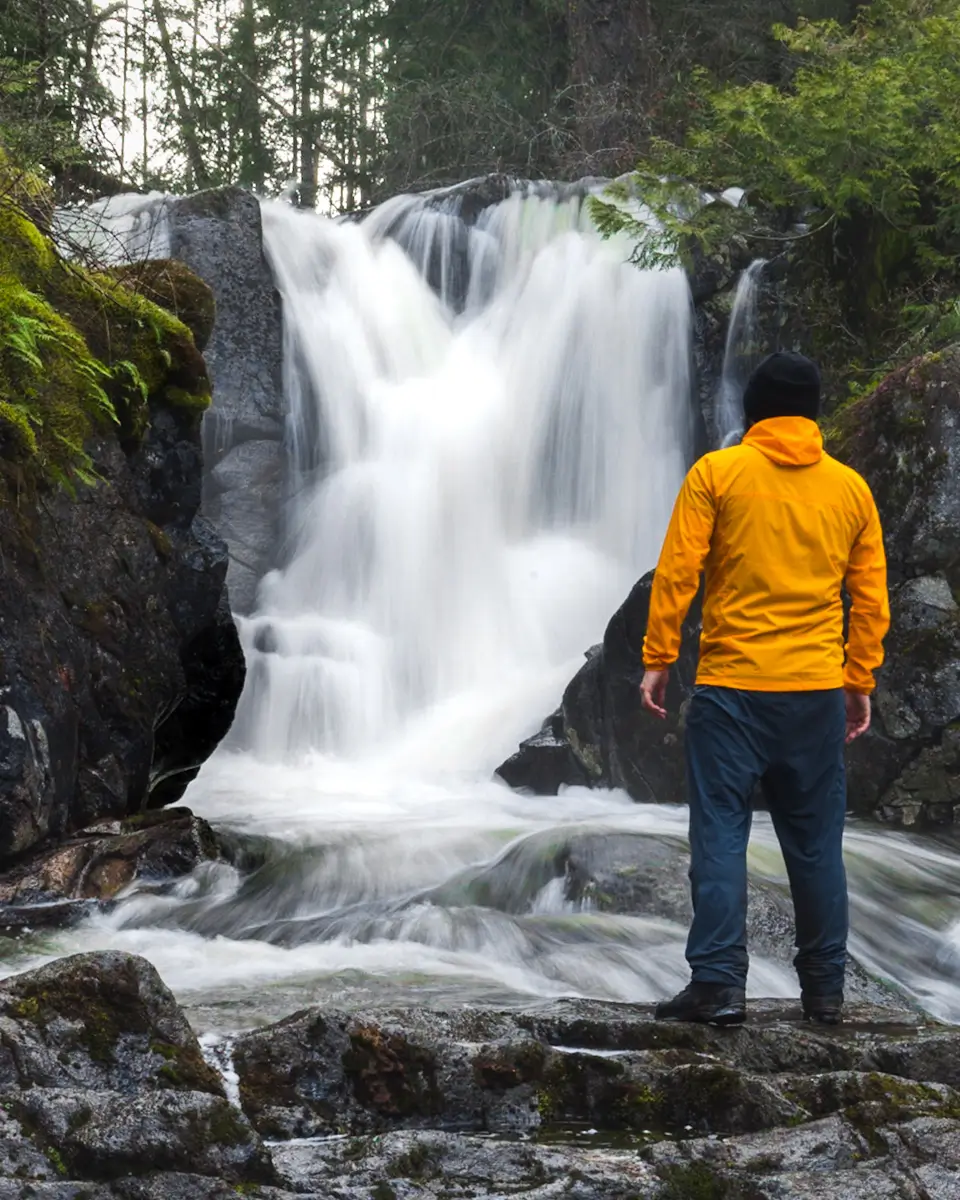
Upper Christie Falls. The creek splits into Lesser Bush Creek and Greater Bush Creek on either side of where I’m standing.
When to Visit Christie Falls
Like all waterfalls on Vancouver Island, the best time of year to visit Christie Falls is the winter months, as well as late fall or early spring. These are the months with the most rain, meaning that visiting waterfalls during this time will guarantee a heavy and dramatic flow of water. That said, Christie Falls flows decently in the summer with the added bonus of being able to approach the falls much closer. I wouldn’t say there’s a bad time to visit Christie Falls.
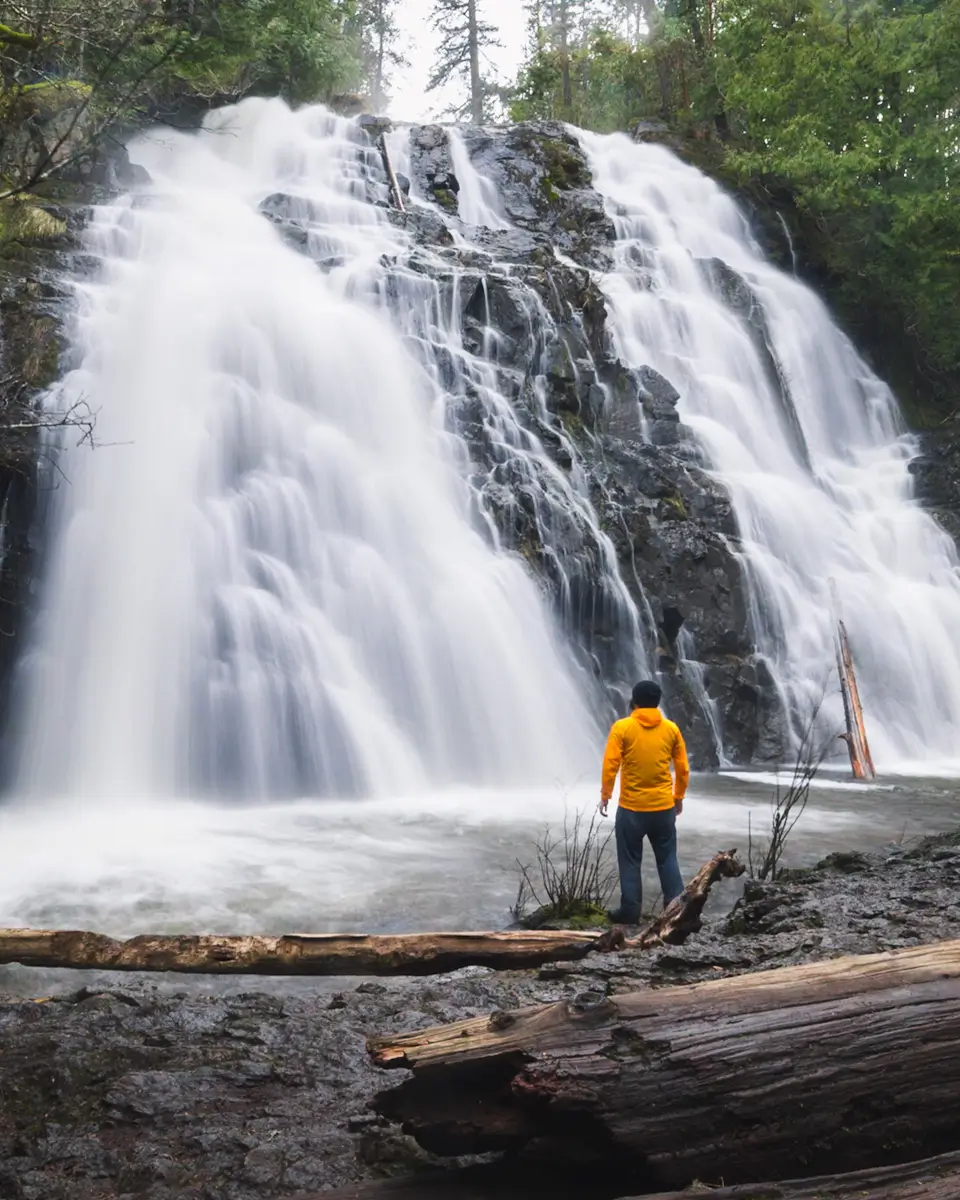
Greater Christie Falls, the largest waterfall on this section of creek.
How to Get to Christie Falls Trailhead
The trailhead for Christie Falls is close to Ladysmith, about twenty minutes from Nanaimo or an hour and twenty from Victoria. At the north end of Ladysmith turn west onto Grouhel Road from the Trans-Canada Highway. Take an immediate right onto Christie Road and follow it as curves past houses for a couple km, becoming Arroyo Road, before turning into logging road. Follow the logging road for about a minute until you see the turnoff with the gate on the right side of the road. Park here without blocking the gate, and begin hiking down the road. Sometimes the gate is open, but it’s not recommended to drive down past it, as it will be closed again without notice, potentially locking you in.
Click here to open the exact trailhead location in Google Maps.
Hiking to Christie Falls
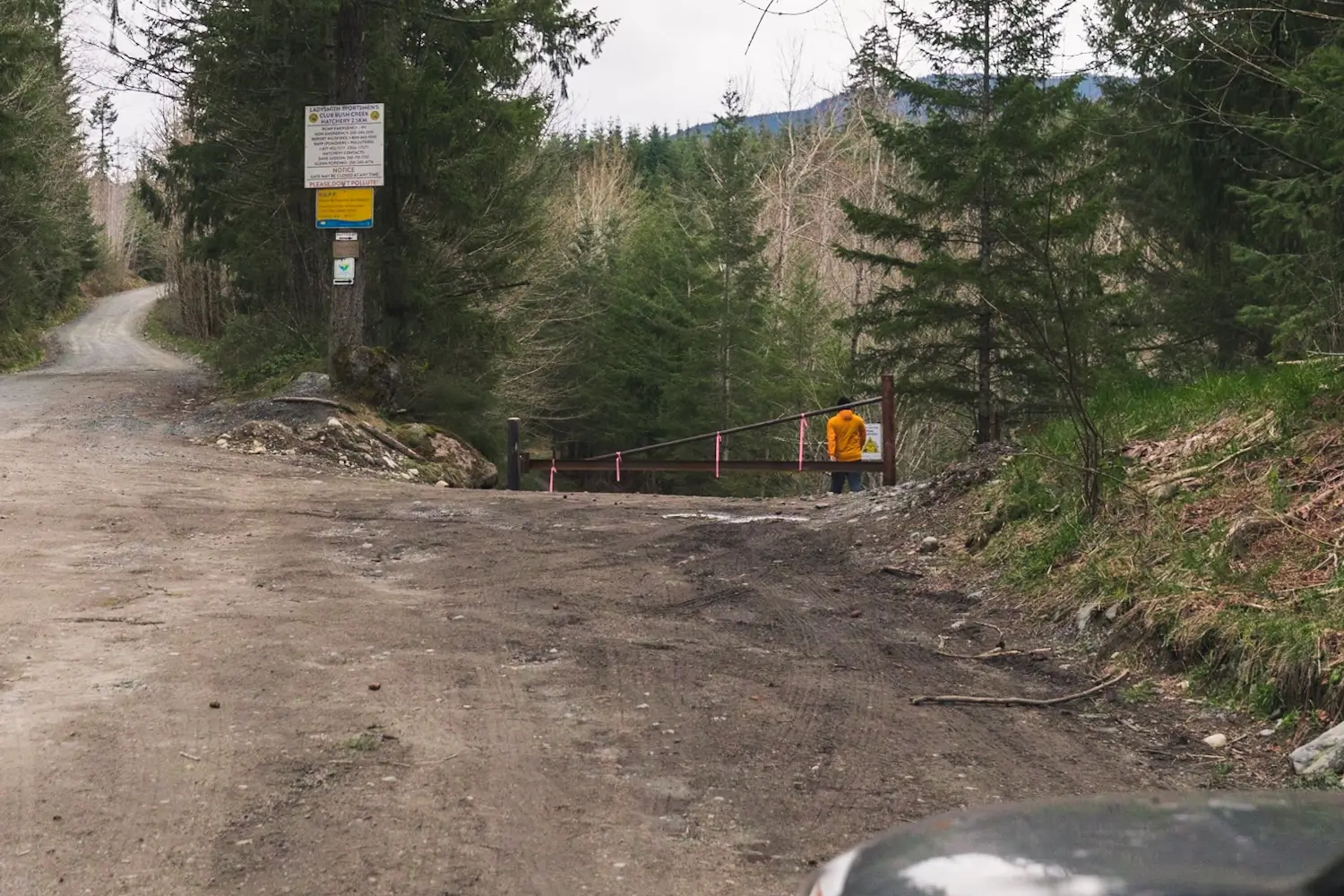
Parked at the side of the road and walking along the old logging road to the hatchery.
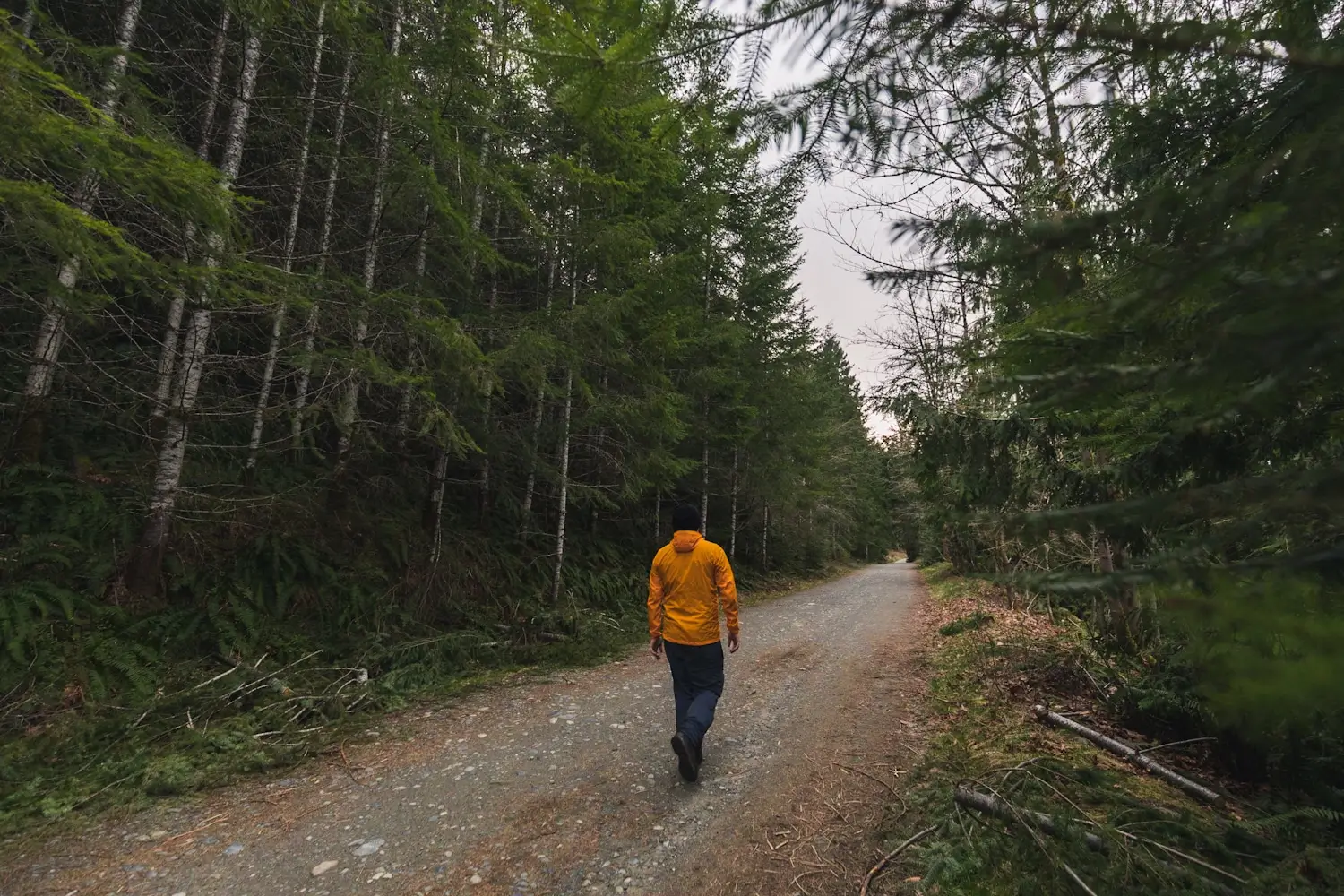
The road is flat, relatively straight, and boring. Bring along a friend to chat with to make this section of the hike go by.
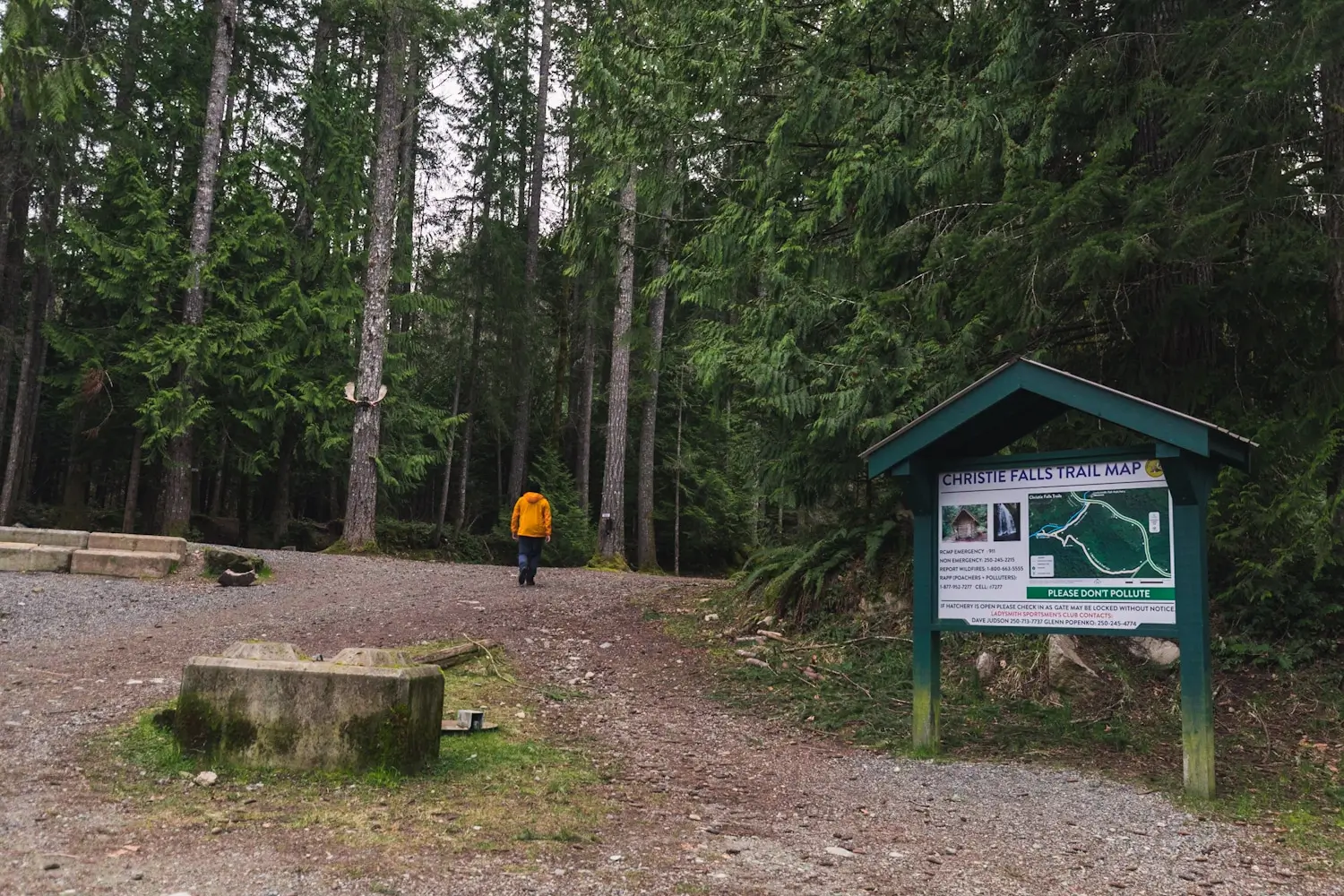
After walking for close to thirty minutes the logging road reaches the hatchery and Bush Creek, with the singletrack trail leading up alongside.
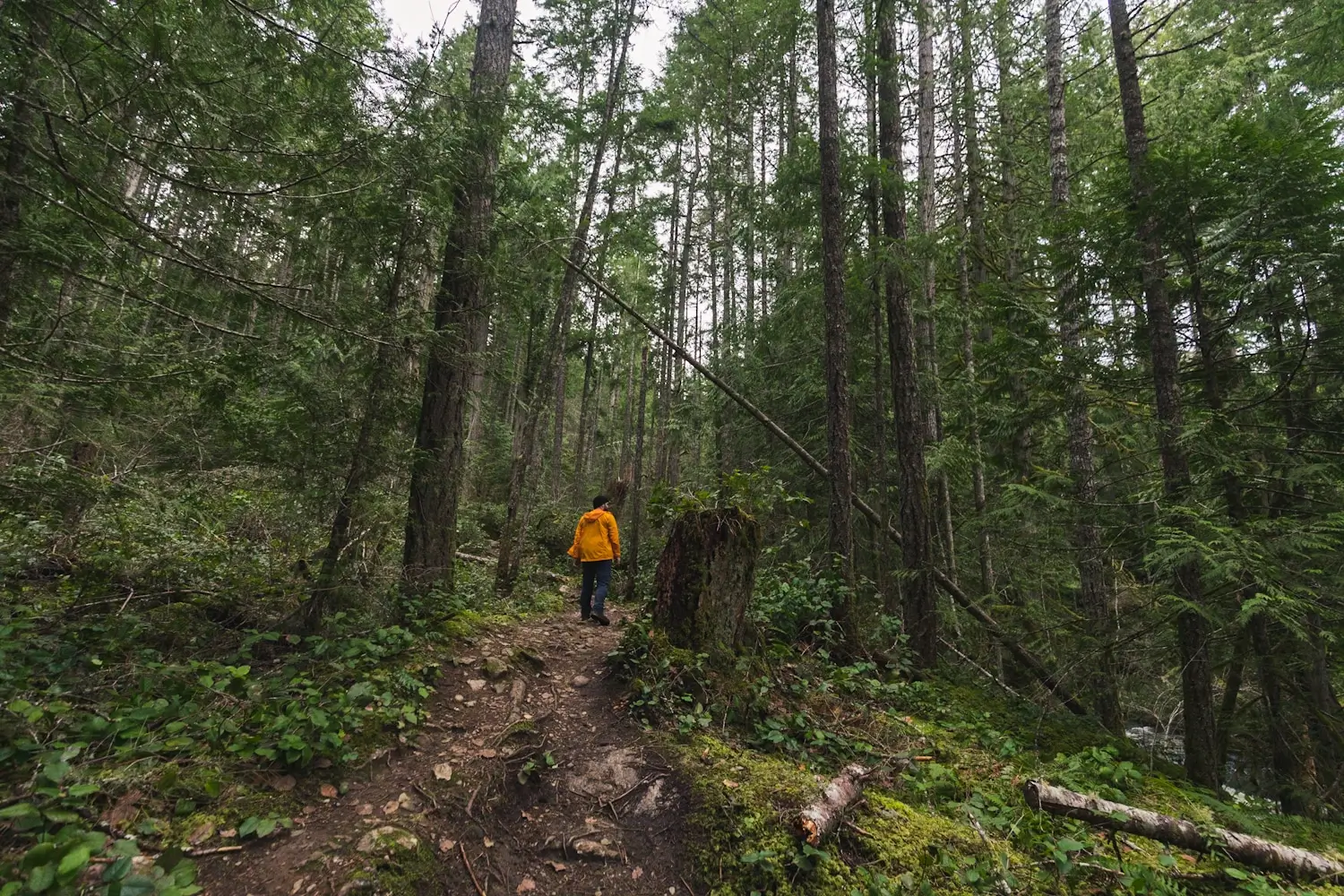
Bush Creek is visible for most of the trail from here, if not very audible as it crashes down the hillside.
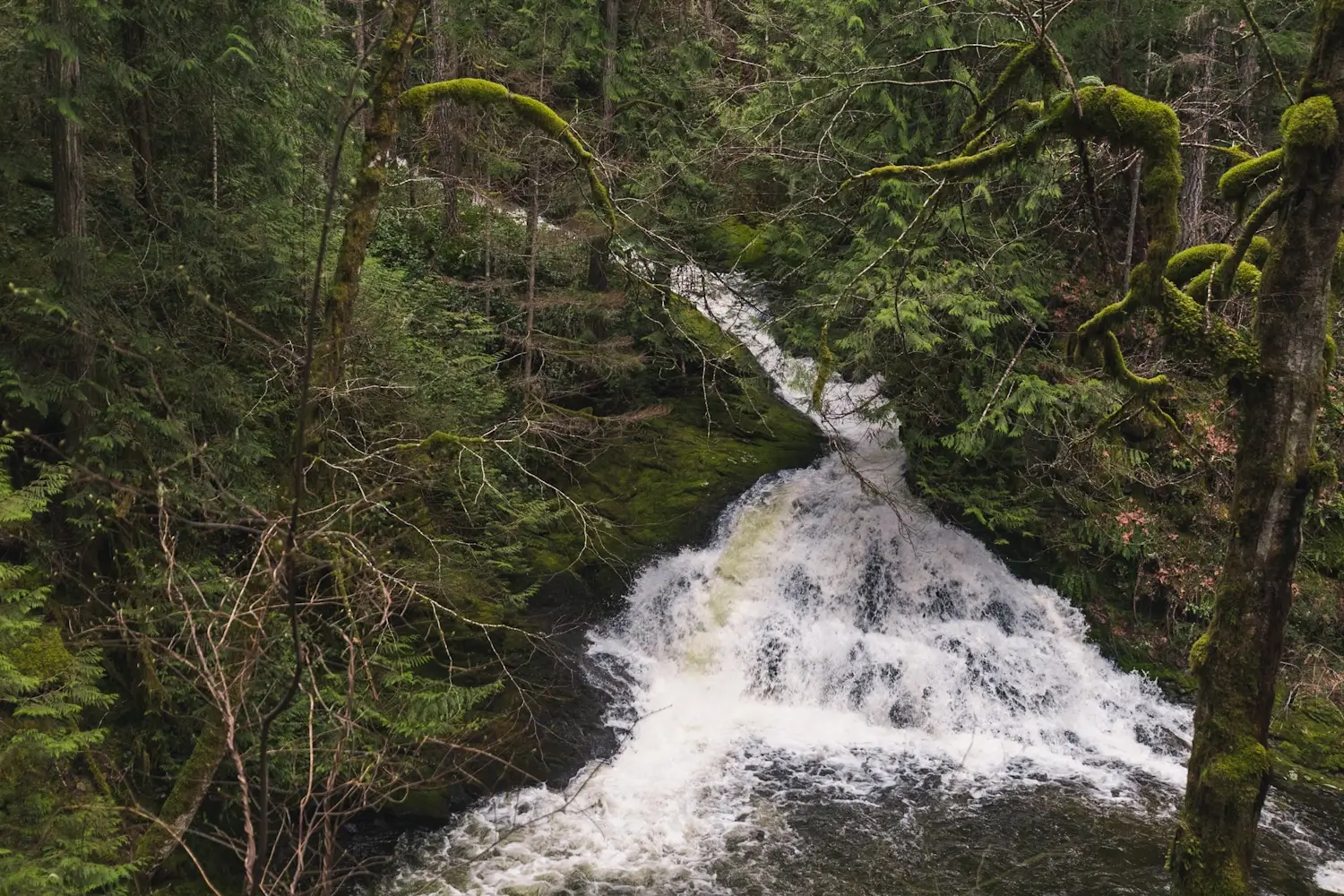
A pleasant waterfall downstream of Christie Falls.
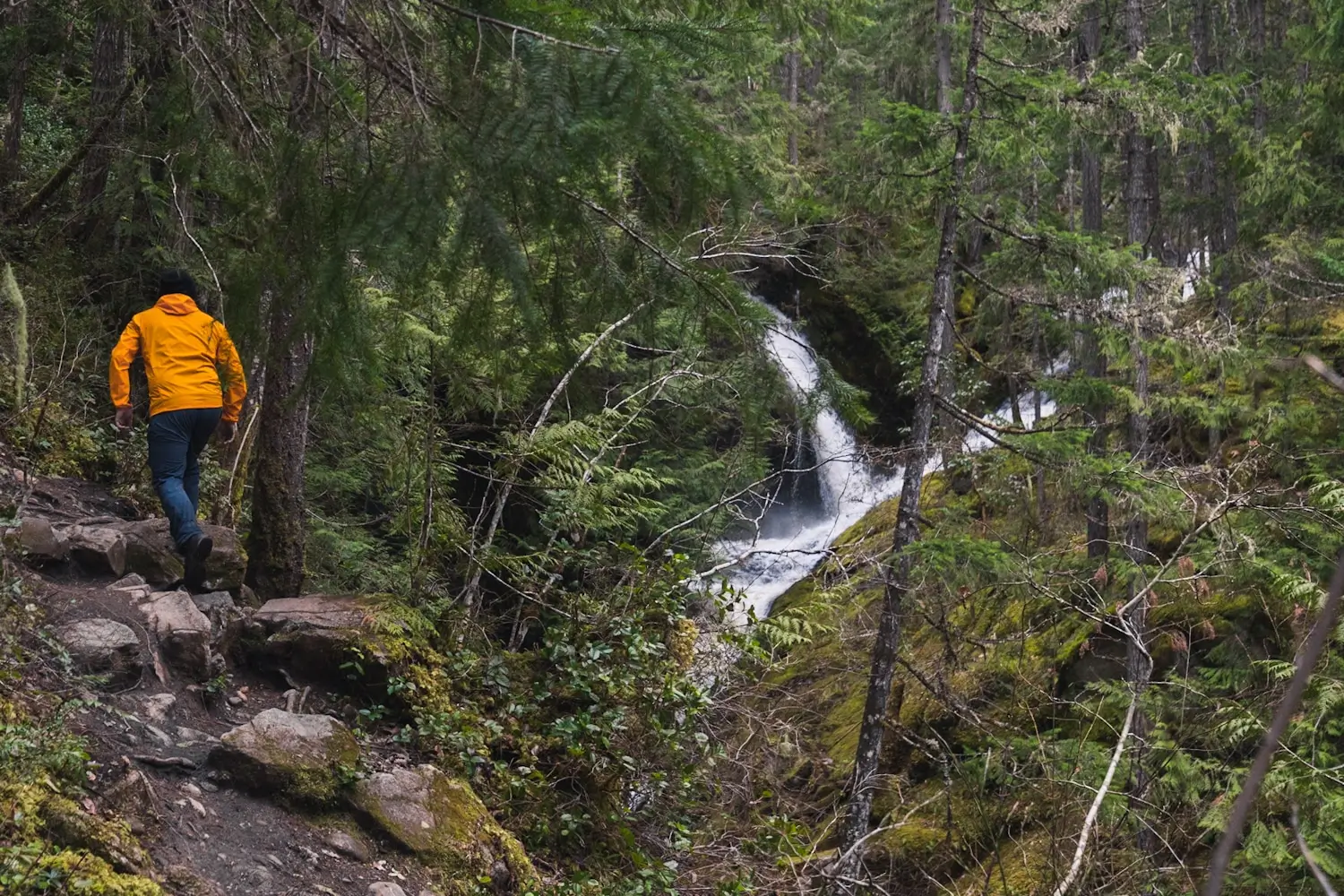
Seen here is Lower Christie Falls, where the separated creeks of Greater and Lesser Bush Creek reunite.
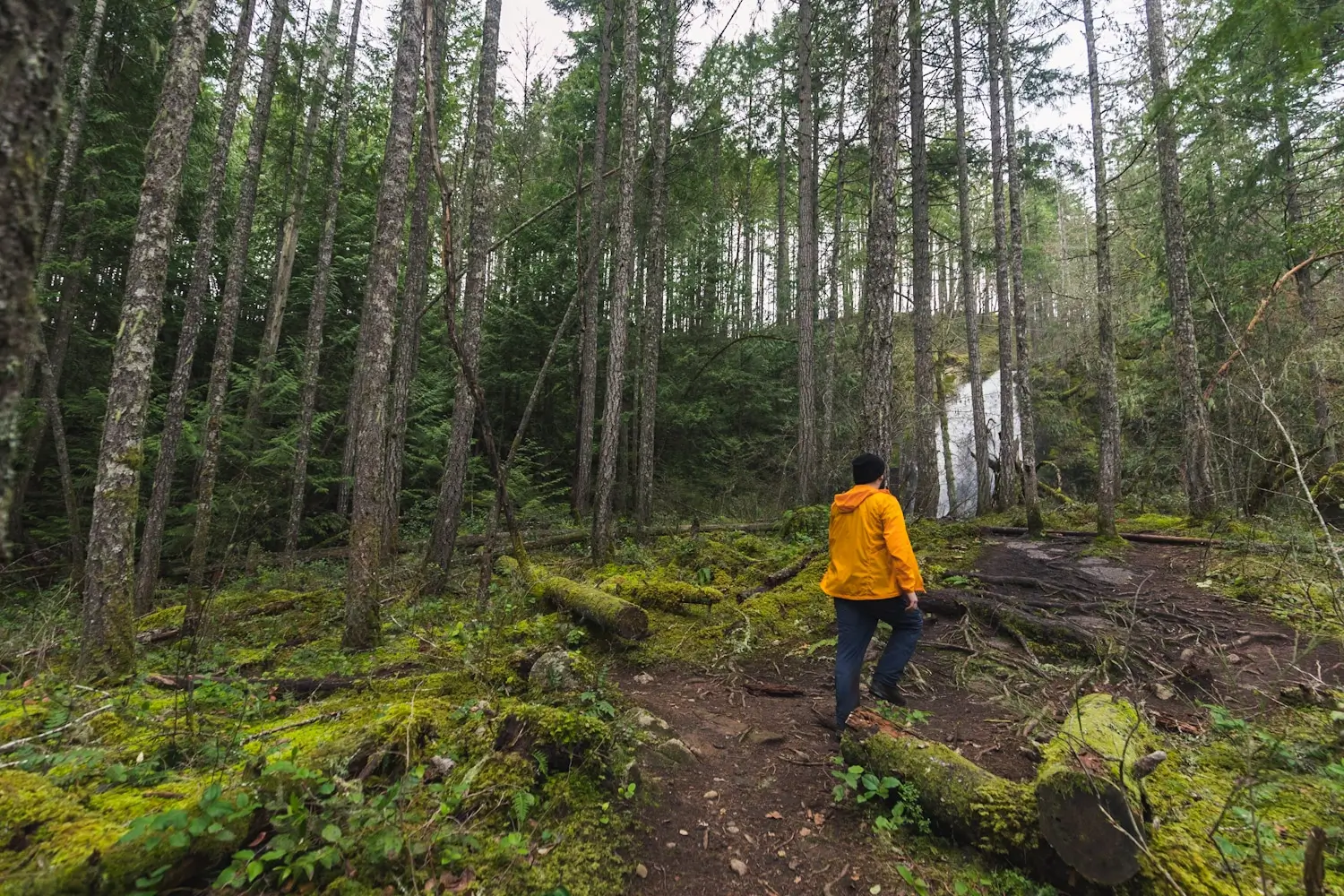
Nearing lesser Christie Falls. Note the trail turning to the left here. This is the way down if taking the cabin route back down.
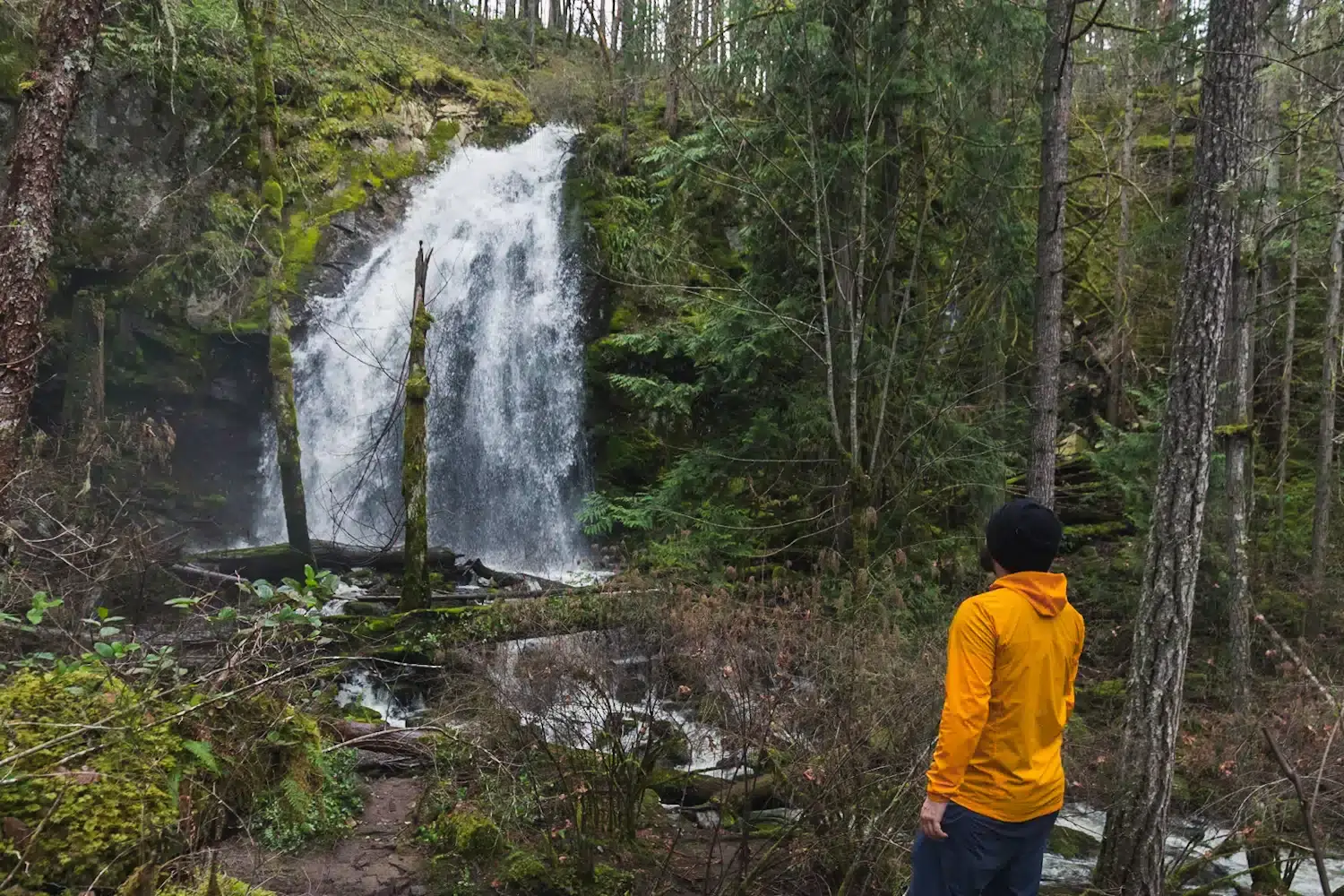
Lesser Christie Falls. What’s great about this waterfall even when it’s really going is that the base is fairly accessible via a trail going around the left side of it. Be prepared to get sprayed though!
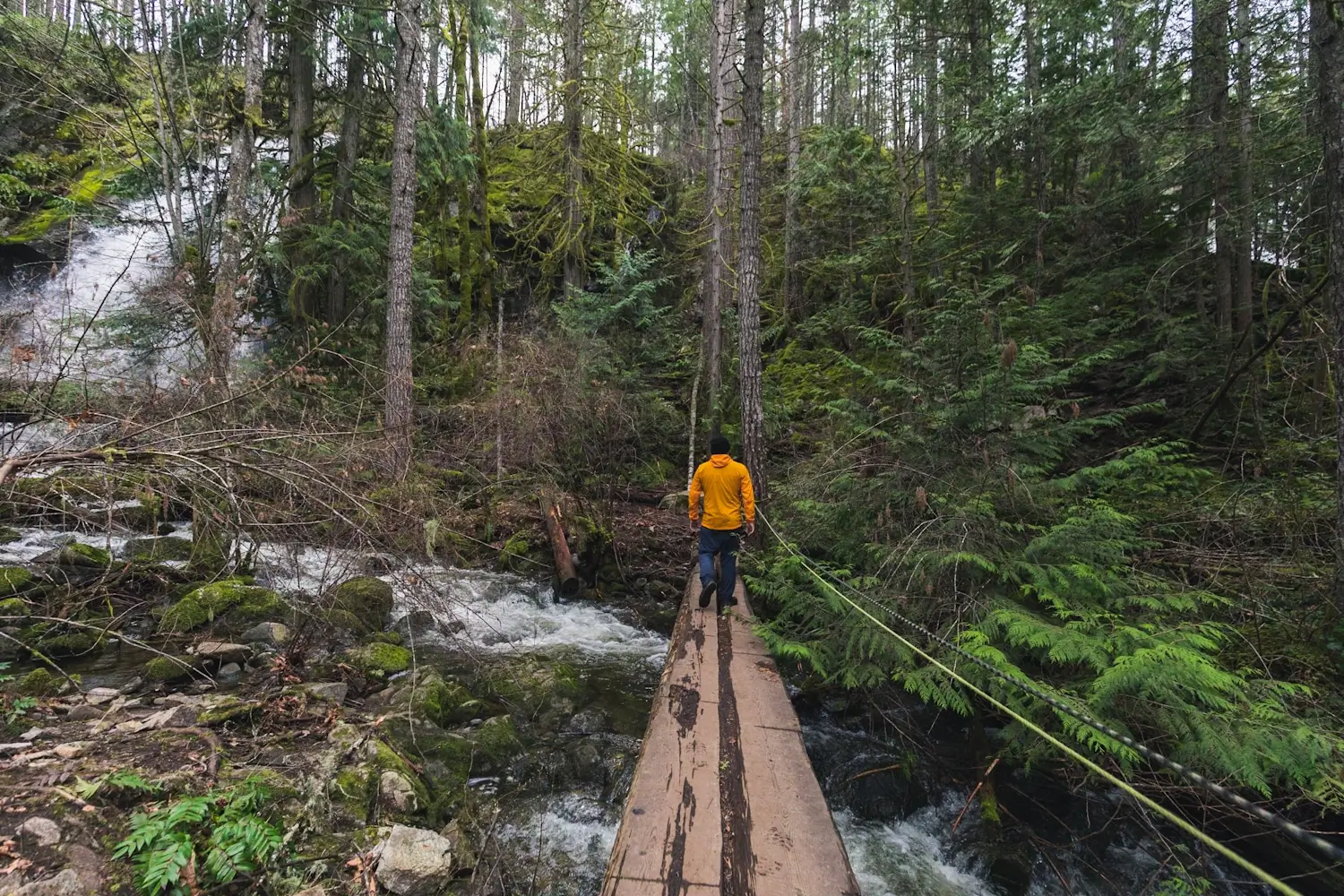
The trail crosses a log bridge at right of the falls before heading up to Greater Christie Falls, already visible through the trees in the top right of this photo.
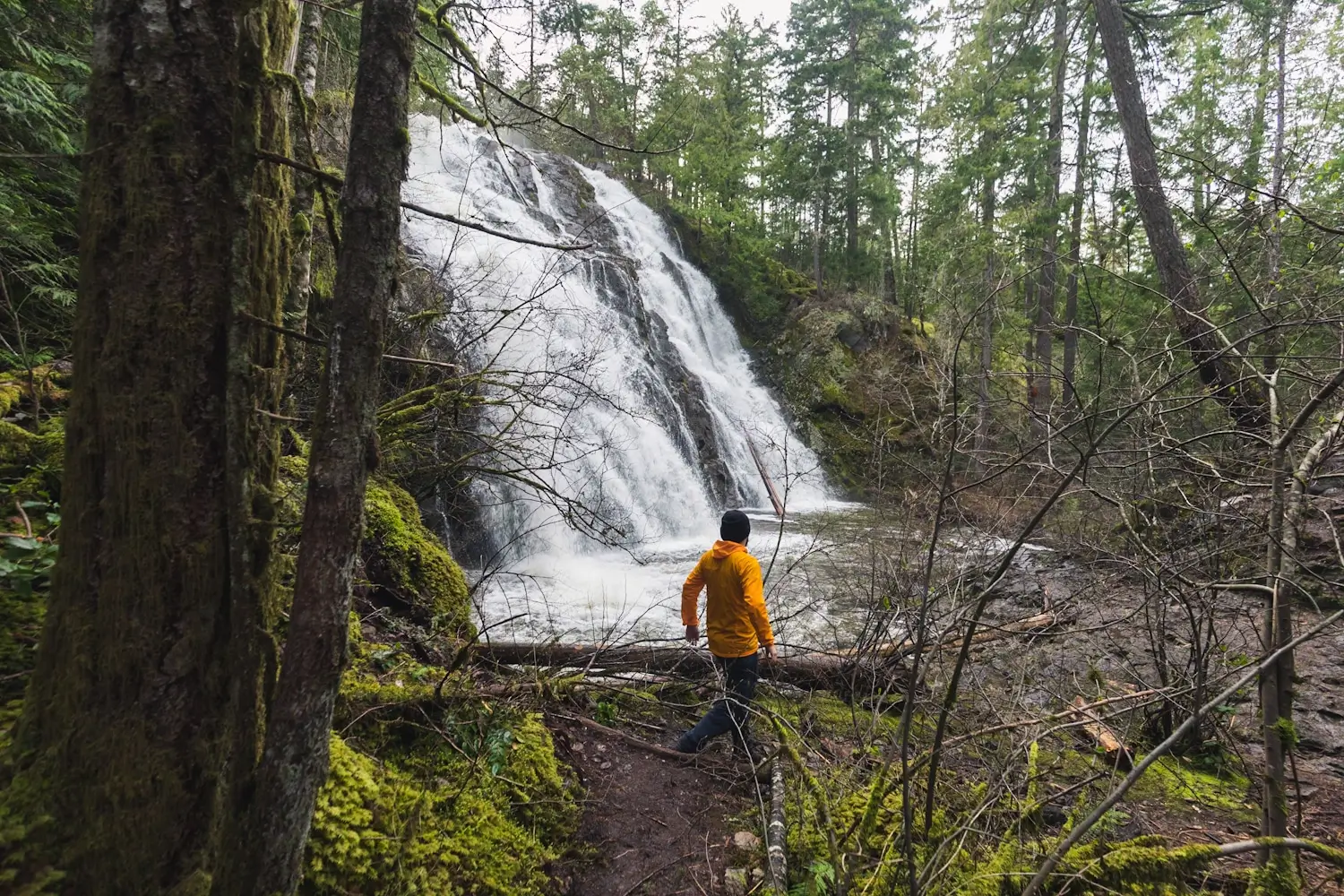
Greater Christie Falls.
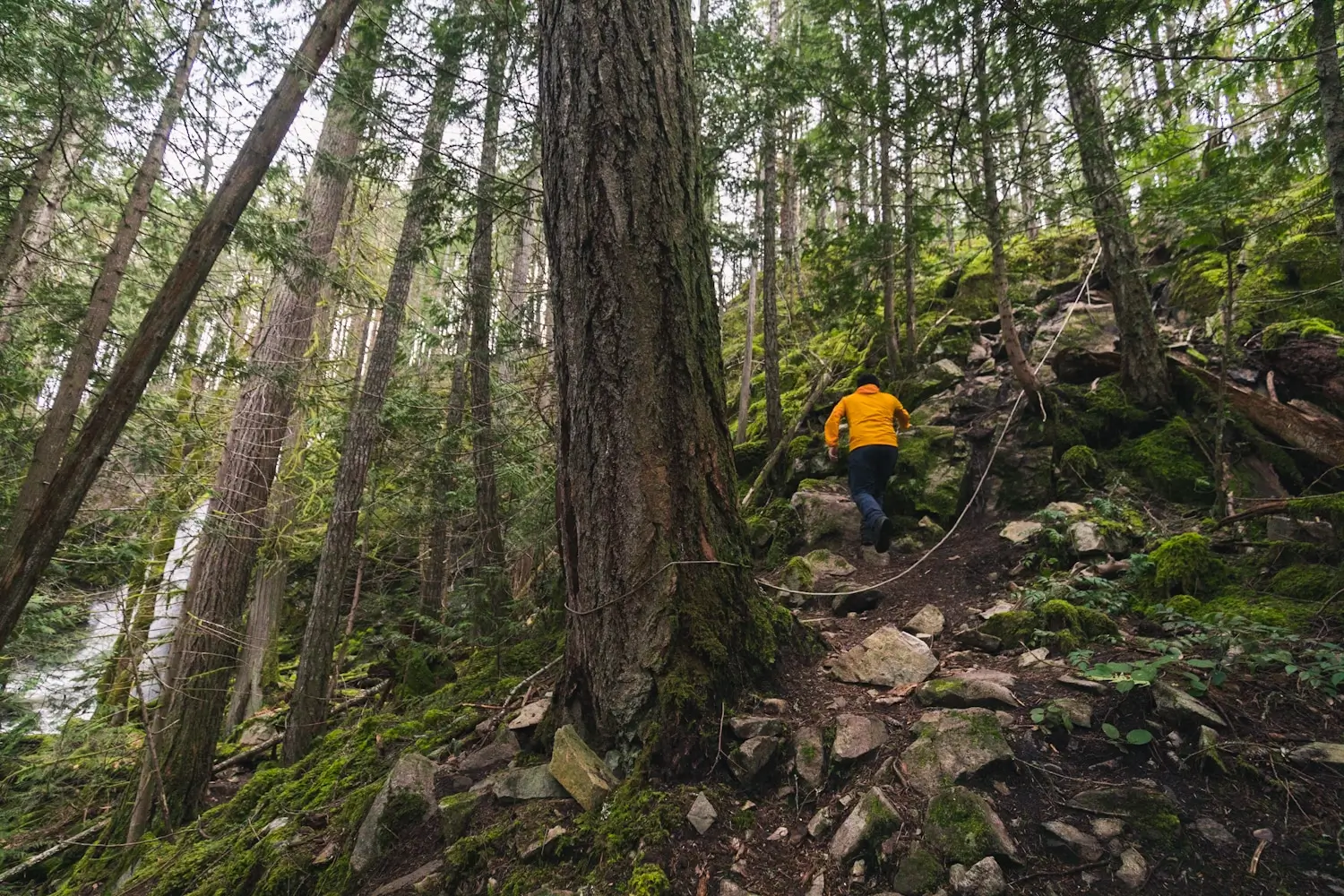
From between the two falls a trail makes its way up the hillside. I though it would be scrambly and steep but too be honest it wasn’t as bad as I expected, though some caution is off course required.
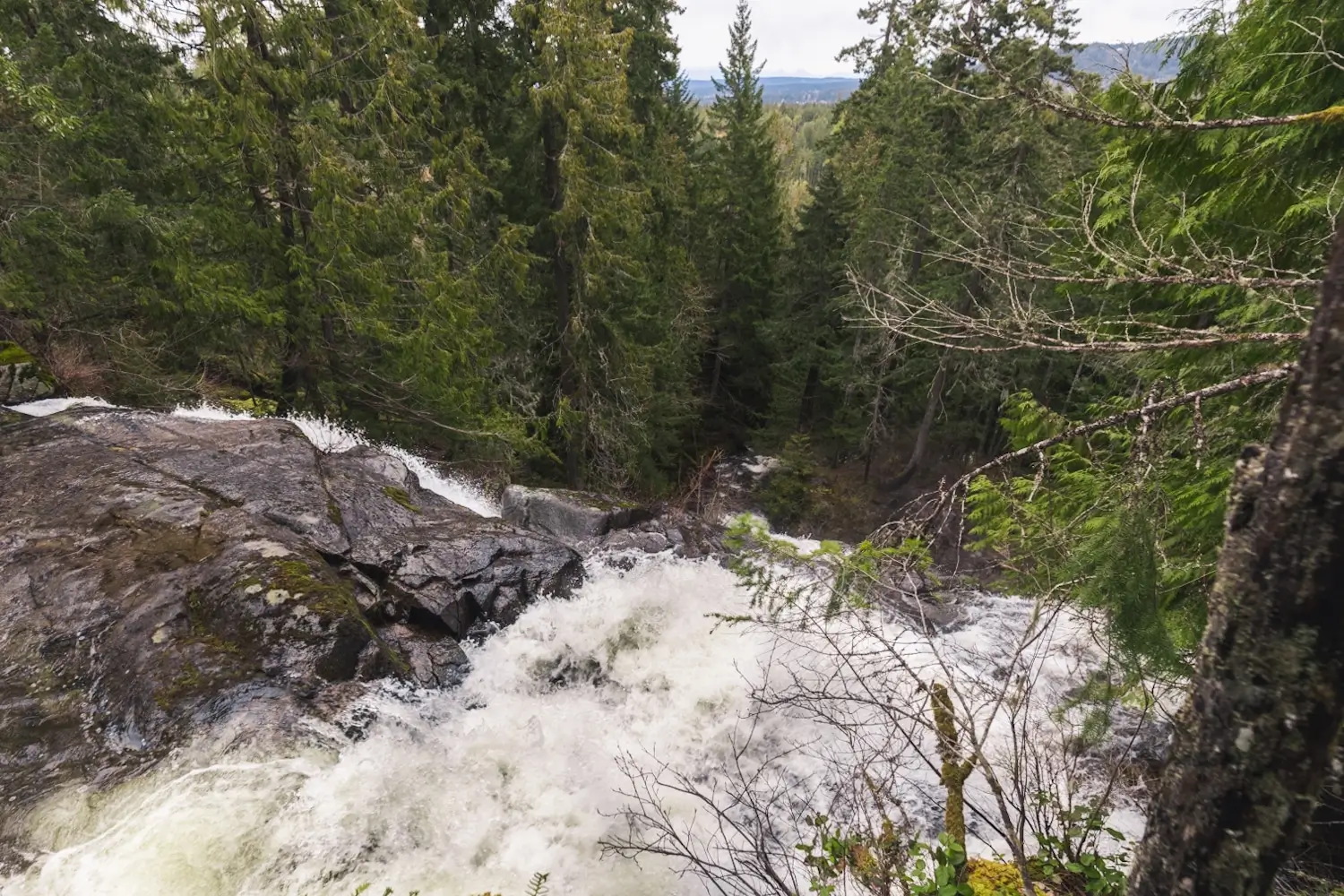
The look down Greater Christie Falls from above.
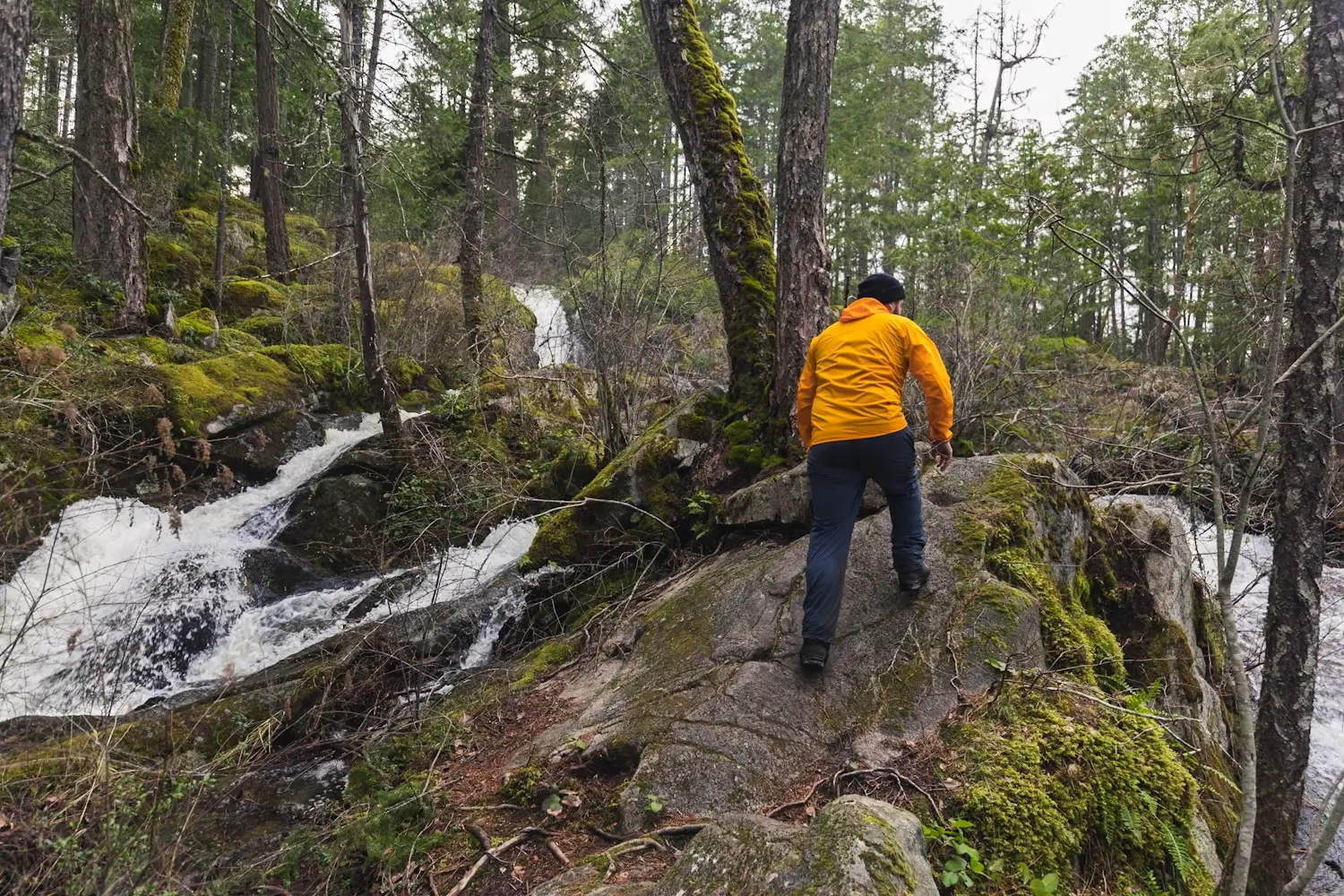
Making my way up to where the creek splits in two. This is where the trail gets dangerous. Close to the creek the rocks are super slippery especially in winter and spring when there’s a lot of spray. Slip and fall here and you die, so be careful.
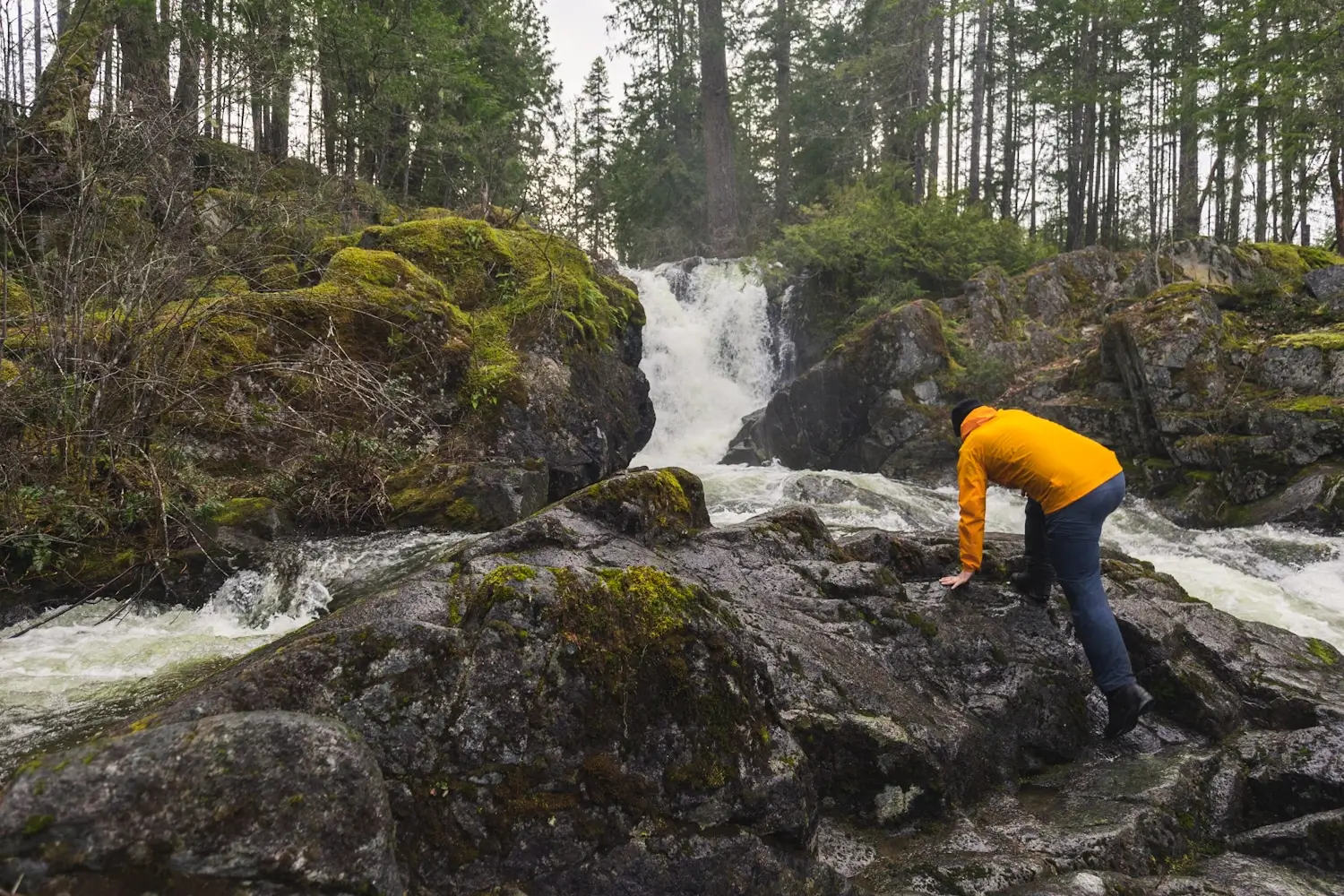
Upper Christie Falls and Bush Creek splitting in two.
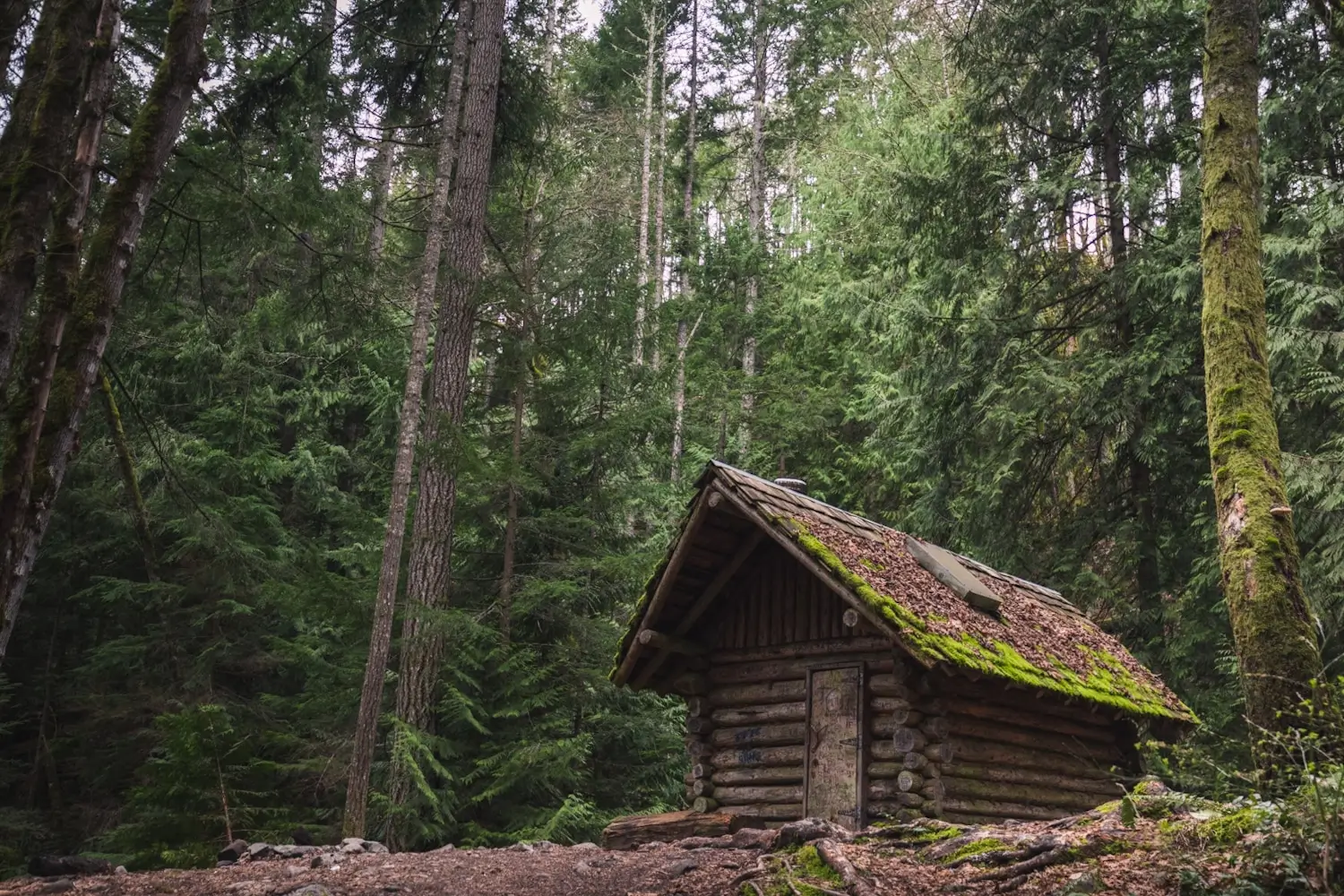
Back down and on the return trail, which skips the views alongside the creek and visits this clearly haunted cabin instead.
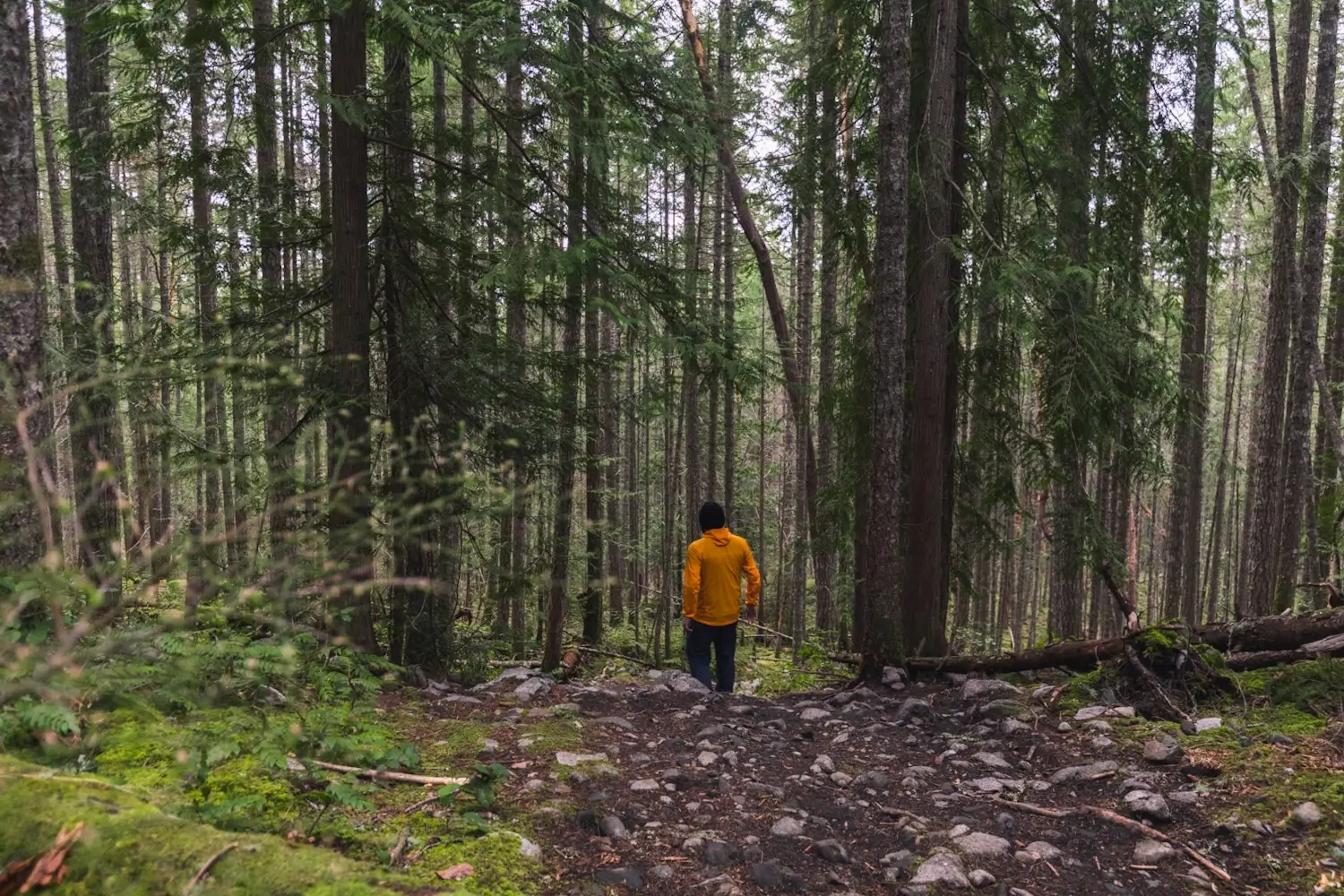
The trail heads down and rejoins the road much quicker than the creekside trail. That said, even though its steeper I still prefer the creek trail for the views.
Recommended Hiking Gear



Water is a must whenever I’m hiking, especially if the sun is going to be out. My favourite water filter I’ve used is the Katadyn BeFree 0.6L, which unlike other water filters I’ve used packs up really small and lightweight. For hikes where I know there won’t be any readily available water sources along the way, I make sure to bring my own. The Hydrapak Stow 1L bottle is my go-to, for the same reason that it’s made of a soft plastic that folds up and doesn’t take up any more extra space than necessary in my pack. Finally, Aquatabs are another great option for purifying water, with one tablet being suitable for one litre of water. I previously used the Grayl water filter while travelling internationally, and though I found its hard body more convenient for day to day use and easier to drink from, it has a little too much bulk for my fast-and-light style of hiking.



The secret to all my photos of gorgeous sunset and sunrise mountaintop views? A lot of hiking in the dark. And let me speak from personal experience when I say that the last thing that you want to happen when hiking is to be caught in the dark without a headlamp. I used the Black Diamond Spot 400 for years and it worked great – until I lost it on top of a mountain somewhere. The only downside to it was having to worry about the batteries dying, though there’s also a slightly more expensive version that has a rechargeable battery. Nowadays I’m using the Petzl Actik Core, which is a bit pricier than the more budget-friendly Black Diamond, but is also brighter, more comfortable (in my opinion), and has a hybrid power system that is rechargeable but can also take AAA batteries if needed.
You won’t see me using trekking poles on shorter hikes often – but on long hikes and backpacking trips, as well as certain scrambles, they are an absolute lifesaver. I’ve invested in a high quality ultra-lightweight pair of MSR DynaLock Ascent carbon poles which, while pricey, I don’t regret one bit. If you’re not entirely sure how much use you’re going to get out of a pair of trekking poles, the best budget-friendly option would be the Trekology Trek Z 2.0. Amazon does sell a lot of cheaper Made in China-style trekking poles for cheaper, but these usually are much much heavier and not worth buying.
All the best and most long-lasting cables and power banks I’ve ever owned have been Anker. I once had a phone cable from them that lasted me over three years of daily use! That’s why I keep an Anker PowerCore Essential 20K power bank on me. Like many people I use my phone for a lot of stuff when hiking (checking in with family, using online maps, taking photos, flying my drone) so I like to be prepared for that low battery warning by having a backup power source on me just in case.



The only socks I ever buy for myself are from Darn Tough, and I almost always make sure to wear them when hiking. After years of having no problems only wearing these comfortable and rugged socks for hikes, I accidentally wore a pair of no-name socks on a hike last year and ended up with blisters on both feet. Safe to say I’m back to sticking with the Darn Tough. And the best part? They have a lifetime guarantee, meaning that if they ever wear out you can send them back for a brand new pair. For hiking footwear I go between a pair of lightweight approach shoes for quick and dirty mountain ascents or anything involving scrambling and more heavy-duty boots for longer treks. I’ve worn a couple different versions of the lightweight but super durable Arc’teryx Konseal FL 2 approach shoes for a few years now and am very impressed with the durability. I also really like the thick toecap that keeps me protected every time I stumble into a root or large rock. For longer, tougher, or muddier treks I rely on my LOWA Camino EVO GTX, which I find insanely comfortable and made of very high quality.



I wear my Ar’teryx Gamma Lightweight Pants on every single hike I go on, and on many days when I’m not hiking. After several years of abuse they are still holding together extraordinarily well, with only a few small holes from where I’ve fallen down and some slight stains from being repeatedly coated with mud. They’re lightweight, breathable, and super comfortable. For lightweight and breathable hiking tops I’m a big fan of both the Patagonia Capilene Shirt and the MEC Core Shirt. My Arc’teryx Squamish Hoody shows up in a lot of my photos. It’s super lightweight and packable, and does a great job of cutting the wind while also being pretty breathable. I also have an Arc’teryx Atom Hoody and Arc’teryx Beta LT that I pull out for cooler or wetter conditions.
I hope you enjoyed this guide to hiking to Christie Falls on Vancouver Island! Feel free to leave any questions in the comment section below or to contact me directly via social media.

Banon creek falls is a must!
Just south of Ladysmith!